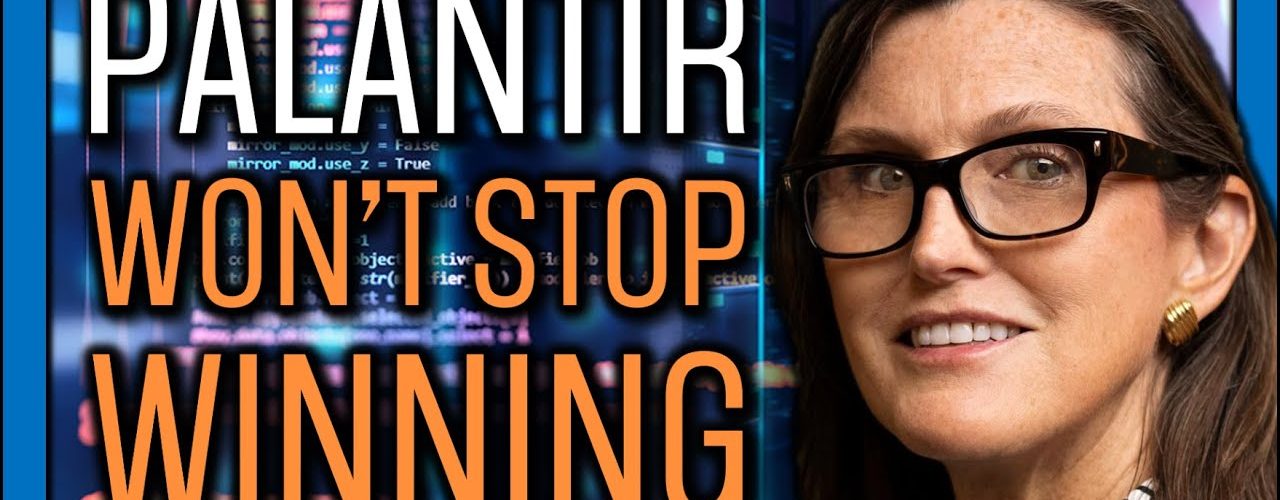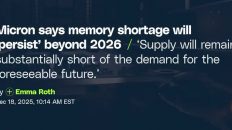Mentioned in Video:
- 🚀 12 Stocks That Could 10X Thanks to Palantir (PLTR): https://www.youtube.com/watch?v=5r3fEl6_e_c
- Tesla AI Day, Dojo, Bot w/ ARK Analysts Will Summerlin & Frank Downing (@Dave Lee on Investing Ep. 415): https://www.youtube.com/watch?v=BaMwFTRfCZA
- Ark Invest Talks Palantir: Analyzed! PLTR's Beachhead Strategy, Competitive Advantages (@Palantir Vision): https://www.youtube.com/watch?v=Q_MflswNGEc
- BlackSky Secures Investment from Palantir and Enters into Multi-Year Strategic Partnership Following Successful Pilot Project: https://ir.blacksky.com/news-events/press-releases/detail/37/blacksky-secures-investment-from-palantir-and-enters-into
- Support the channel and get extra member-only benefits by joining us on Patreon: https://www.patreon.com/tickersymbolyou
🚀 #CathieWood and #ARKInvest analyst Will Summerlin recently provided a lot of great context on #Palantir (#PLTR stock) as well as their investments into companies like #BKSY (Blacksky stock). Let me clarify @ARK Invest‘s recent comments on Palantir's technologies and moat by sharing some of my own experience in the space.
Video Transcript:
00:00
recently kathy wood and analysts from
00:02
arkhanvest have shared a lot of fresh
00:04
insights on palantir ticker symbol pltr
00:07
palantir has quickly become one of ark
00:09
invest's biggest holdings weighing in at
00:12
just under a billion dollars across all
00:13
of their funds combined it's also one of
00:16
only two stocks that kathy wood has put
00:18
inside all six of arkhanvest's funds
00:20
with the other being uipath ticker
00:23
symbol p-a-t-h in this episode i want to
00:26
add a little context to a clip from dave
00:28
lee's recent interview with will
00:29
summerlin an arc invest analyst who
00:32
focuses on artificial intelligence and
00:34
software as a service as well as frank
00:36
downing who focuses on cloud computing
00:39
software as a service and crypto assets
00:41
the goal of this episode is to showcase
00:43
palantir's versatility as an artificial
00:45
intelligence and data analytics company
00:48
as well as highlight how they're using
00:49
their growing moat on the government
00:51
side to power their down market
00:53
expansion on the commercial side and
00:55
vice versa because your time is valuable
00:57
i've edited these clips down to just the
00:59
essentials and time stamps are enabled
01:01
for your convenience in case you want to
01:03
skip the clips altogether and go
01:04
straight to my analysis let's start with
01:06
the clip of will summerlin talking to
01:08
dave lee about arc invest's thesis on
01:11
palantir i want to
01:13
ask you about palantir so i know arc you
01:15
guys have been you know buying some
01:17
pounds here and
01:19
have you been able to i don't know
01:22
evolve some thinking and where do you
01:24
current where do you currently stand on
01:26
for example their ai expertise their
01:29
defensible let's say mode or advantage
01:31
and like you know their
01:33
projections to grow revenue let's say
01:35
even 50 or more per year for the next
01:37
five years
01:39
yeah it's it's a great question um you
01:42
know i think there are a couple trends
01:43
that i think are interesting with
01:44
palantir uh you know they got a tail one
01:47
from covid with government contracts and
01:50
i think as we started to exit cove then
01:53
i guess you could argue now start to
01:55
re-intercovet to a degree
01:57
um you know that tailwind hasn't slowed
01:59
down in the sense that while maybe their
02:01
core contracts related to covet are
02:04
running up um we see you know government
02:07
agencies with federal state uh across
02:10
the world
02:11
reintroducing palantir to solve other
02:13
problems within their their agency and
02:15
so i think for for government side of
02:18
palantir i think coveted was actually a
02:20
great beachhead into many organizations
02:22
and agencies across the world that they
02:24
wouldn't have worked with otherwise or
02:26
would have worked with much later in
02:27
their life cycle
02:28
um and so i think there's a strong
02:30
tailwind of sort of government adoption
02:32
in that sense and i think from an
02:34
enterprise perspective uh you know they
02:36
gave an example in their last hoodings
02:37
call
02:38
where uh you know boeing actually
02:41
switched to a joint venture software
02:44
platform of palantir and airbus away
02:46
from something that they home grew with
02:47
microsoft
02:49
i think that's a great sort of
02:50
indication as to what's happening across
02:52
the board with
02:53
enterprises when it comes to palantir
02:55
you know often they're competing with a
02:56
homegrown solution um you know in many
02:59
cases it's palliative versus hey let's
03:01
build this platform ourselves
03:03
uh and you know there are certain
03:05
advantages to doing both but it seems
03:07
like the
03:08
the the choice is tipping towards
03:09
palantir in many cases
03:12
and we think that's going to continue
03:14
also interesting is the sort of move
03:15
down market in the activity with spack
03:17
investments
03:19
and their thesis around this is hey you
03:21
know we're going to invest in a company
03:23
early in its life cycle get them to
03:25
build their company on top of our
03:26
platform and then we'll grow with them
03:29
you know and i think this sort of
03:31
organic story of hey we're going to be
03:33
the platform that helps a company build
03:35
their first product or build a series of
03:37
products and then grow with that company
03:39
is really interesting we saw that with
03:41
twilio
03:42
you know for a long time that's what
03:43
drove twilio's growth is these you know
03:46
companies like uber who use them very
03:48
early on to actually build their
03:50
technology to build their product and
03:51
then you know twilio benefit and that
03:53
they grew with uber
03:54
um
03:55
and you know to me palantir is
03:56
interesting in that that's sort of a new
03:58
customer demographic
04:00
where i think there's a lot of
04:01
greenfield opportunity you have the
04:03
government sector which we just talked
04:05
about that has that kind of tailwind
04:06
continuing and then you also have the
04:08
traditional enterprise you know
04:10
pallentry started uh in the commercial
04:11
side with big enterprises right selling
04:13
10 million dollar contracts to you know
04:16
giant companies
04:17
and i think that's continuing um you
04:19
know i think companies are acquiring
04:21
more data than ever um you know they
04:23
need to start to layer ai on top of all
04:26
of their uh you know all of their their
04:29
their processes in order to stay
04:30
competitive and i think palantir has
04:32
sort of been an advantaged position to
04:34
help those companies through that
04:35
transition uh so overall yeah i think
04:37
it's it's an interesting story um you
04:40
know given all of that and given sort of
04:42
the head start that they had many many
04:43
years ago with the government um i think
04:45
it'll be an interesting story over the
04:47
next five or ten years so first off a
04:49
big shout out to the youtube channel
04:51
palantirvision who also covered this
04:53
clip a few days ago and made me aware of
04:55
its existence if you're interested in
04:57
keeping up with all things palantir i'll
04:59
leave a link to that channel in the
05:01
description below along with dave lee's
05:03
full interview with will summerlin and
05:05
frank downing i think will summerlin did
05:07
an excellent job highlighting two
05:09
important things about palantir that
05:10
apply everywhere from giant government
05:12
contracts down to small and medium-sized
05:15
businesses those two things are that
05:17
every company today is operating in an
05:19
increasingly data-rich environment and
05:22
that palantir is often competing with
05:24
home-grown solutions i worked on a lot
05:26
of government projects during my eight
05:28
years at mit so let me shed some light
05:30
on why i think well summerlin's
05:31
commentary on palantir is so spot on a
05:34
lot of government projects are about
05:36
generating unusual insights or
05:38
processing unusual data sets like data
05:41
that comes from specialized sensors and
05:43
systems for example radar and satellites
05:46
not everyone has access to that data so
05:48
not everyone can really help with that
05:50
data processing other times the data
05:52
itself might not be unusual but the
05:54
conclusions you're trying to draw from
05:56
it could be for example can we process
05:59
google earth data to somehow sniff out
06:01
networks of bad guys even though
06:03
everyone has access to google earth
06:05
systematically sniffing out bad guys is
06:07
the job of a small pool of organizations
06:09
and how they go about doing that should
06:11
obviously be kept under wraps as the
06:14
world becomes more and more data rich
06:16
more and more companies are trying to
06:17
generate more of these unusual insights
06:20
from more specialized types of data to
06:22
do that successfully they often have to
06:24
build their own solutions that's how
06:26
these two ideas are connected and that's
06:28
the space that palantir operates in the
06:30
next point well summerlin makes is that
06:32
companies are increasingly choosing
06:34
palantir over building their own
06:35
home-grown solutions sometimes even
06:37
after their own solution already exists
06:40
like how boeing switched away from
06:41
something they homebrewed with microsoft
06:43
to a joint venture platform built with
06:45
palantir and airbus why do you think
06:47
they would ever do that well havoc
06:49
listen to this quick clip on palantir
06:51
from kathy wood's recent interview with
06:53
bloomberg businessweek and then i'll
06:55
explain how everything fits together
06:57
have kathy talk about palantir and her
07:00
recent buy
07:01
we believe that palantir has
07:04
the opportunity
07:06
to usurp a lot of aws azure
07:11
google compute
07:13
over time it is pushing uh artificial
07:17
intelligence out to the edge and
07:19
palantir because i think it's roughly 60
07:23
percent of its business has been with
07:25
the government
07:26
much of that in intelligence agencies
07:29
talenteer is using technologies that we
07:32
will find out about
07:34
five years from now they we believe are
07:38
so far ahead because of their expertise
07:42
uh in intelligence
07:45
uh that
07:46
it's going to accrue to the company's
07:49
benefit in the commercial space as well
07:51
so they've entered i think a year ago 85
07:54
percent of their business was with the
07:56
government today it's closer to 60
07:58
percent
07:59
uh and so we've got um all of the
08:02
commercial uh side to go so
08:05
uh i i don't think people understand how
08:07
advanced talent here is technologically
08:10
and how its platform technologies
08:13
pushing a out to the edge are going to
08:16
really take share over time
08:18
from the more centralized services it's
08:21
interesting that we're thinking about
08:23
them that way now in the cloud so the
08:26
reason to go with palantir over other
08:28
software companies is because they're
08:30
able to push ai out to the edge meaning
08:32
processing the data right where it's
08:34
generated instead of having to move it
08:36
off site or store it on the cloud that's
08:39
exactly what allows talenteer to work
08:40
with intelligence agencies in the first
08:42
place they bring the data aggregation
08:45
transformation interpretation and
08:47
visualization to the source instead of
08:49
making their clients make concessions to
08:51
use pound here the reason to go with
08:53
palantir over homegrown solutions is
08:55
twofold first palantir now has a lot of
08:58
pre-built use cases that come ready to
09:00
use and get the client maybe 75 of the
09:03
way to the solution they need fairly
09:05
quickly oh you're working with airborne
09:07
camera data no problem we've worked with
09:09
that before so we can at least stand up
09:11
the basics the data handling the
09:13
geolocation basic feature recognition
09:15
and so on the second reason to go with
09:18
palantir over homegrown solutions is
09:20
because as technologies and programming
09:21
languages change or companies lose key
09:24
personnel their own solutions become
09:26
obsolete especially if they're only used
09:29
on one or two small programs within an
09:31
agency when palantir makes updates to
09:33
the models and the toolkits and the
09:35
technologies inside their gotham foundry
09:37
and apollo platforms those changes are
09:40
paid for by and to the benefit of many
09:43
organizations at once meaning that
09:45
they're much less likely to go obsolete
09:47
because any one program office gets its
09:49
budget cut that's what lets them stay
09:51
about five years ahead of their
09:52
competition which isn't able to get
09:54
these kinds of contracts in the first
09:56
place and start learning about all the
09:57
techniques and data that the government
09:59
is using today and the private sector
10:02
won't see that until a few years from
10:03
now don't forget almost every
10:05
foundational technology we rely on from
10:07
the computer to the internet to gps
10:10
started out in the government the other
10:12
two points that will summerlin makes are
10:14
about palantir moving down market
10:16
through their spac investments as well
10:17
as being able to apply their lessons
10:19
learned to traditional enterprise
10:21
companies let me show you one of
10:23
palantir's recent spack investments that
10:24
i feel really brings this point home
10:26
black sky is a company that runs its own
10:28
constellation of satellites to image
10:30
locations around the world multiple
10:32
times per day they now trade under the
10:34
ticker symbol bksy after their
10:37
successful spec merger with osprey
10:39
technology acquisition corp that
10:40
completed just a couple days ago black
10:43
sky collect and analyze satellite
10:45
imagery around the world to do things
10:46
like secure seaports and airports track
10:49
progress of construction sites measure
10:51
stockpiles of materials in industrial
10:53
zones assess damage done by natural or
10:55
man-made disasters and things like that
10:58
think about how many different types of
10:59
companies could benefit from that kind
11:01
of data whether they're building stuff
11:04
moving stuff storing stuff or just want
11:06
to send notifications to different areas
11:08
depending on what they see is happening
11:10
there well on august 31st palutear has
11:13
committed to making an equity investment
11:15
in black sky following the successful
11:17
completion of a joint pilot program that
11:19
they ran together through this pilot
11:20
project black sky automatically
11:22
delivered insights and intelligence to
11:24
pounce your customers within minutes of
11:26
collection without any human interaction
11:29
the ability to deliver worldwide
11:31
intelligence that can inform proactive
11:33
strategic decision making introduces a
11:36
significant advantage to time sensitive
11:38
operations like the security and
11:40
logistics ones i just mentioned to
11:43
extend the benefits demonstrated by the
11:44
pilot project black sky also entered
11:47
into a multi-year software subscription
11:49
agreement with palantir to access
11:51
palantir foundry here's a quote from
11:53
brian o'toole black skies ceo this
11:56
collaboration further enables black sky
11:59
to put the power of real-time
12:00
intelligence in the hands of the user by
12:03
allowing palantir customers to directly
12:05
task our satellites reduce
12:06
decision-making timelines and increase
12:09
the delivery of on-demand insights and
12:11
with our partnership with palantir will
12:13
be able to accelerate our go to market
12:15
plan expanding our pipeline of
12:17
commercial and government customers
12:19
around the world
12:20
so not only does palantir benefit from
12:22
black sky's accelerated growth from
12:24
building on top of foundry but palantir
12:27
also gets to learn about how to pipeline
12:29
and process all of black sky satellite
12:31
data for commercial applications
12:33
remember the google earth example i
12:35
mentioned earlier well it's not a
12:36
stretch to imagine that one day we'll
12:39
all have access to really high quality
12:41
real-time satellite imagery of the
12:43
entire world just like we have access to
12:45
gps in google earth today you can
12:48
already use google earth for a wide
12:49
variety of commercial services from
12:51
navigation to reviews to historic tours
12:54
and just plain digital exploration
12:56
imagine what kind of new applications
12:58
could be built on top of a real-time
13:00
view of the entire world applications
13:02
for logistics planning and execution
13:04
helping emergency services really good
13:07
weather detection and so on and since
13:09
many surveillance satellites today are
13:11
government assets guess who's already
13:13
five years ahead on working with that
13:15
kind of data that's the big moat and key
13:18
advantage that kathy wood and
13:19
arkhanvest's analysts are talking about
13:21
i know it's hard to understand what
13:23
palantir does exactly especially since
13:25
many of the things they work on aren't
13:27
part of our daily lives today i think
13:29
that satellite imagery is a great
13:31
example since it used to be basically
13:33
government only before google and garmin
13:35
and other big tech companies really
13:37
unlocked it for everyone but in low
13:39
resolutions and at slow update rates
13:41
that have been getting better and faster
13:43
over time so hopefully this episode
13:45
provided some clarity on how palantirs
13:47
work with the government and their
13:49
investments in high-tech specs like
13:50
black sky are allowing them access to
13:52
the future versions of those same kinds
13:55
of use cases as well as those data sets
13:57
before many of their competitors and
13:59
before those use cases become
14:01
commercially mainstream if you're
14:02
interested in seeing some of the other
14:04
crazy futuristic companies that palantir
14:07
has invested in i made an episode
14:08
showcasing 12 of their other spac
14:10
investments each of which could offer
14:12
clues about future use cases like the
14:14
ones i just covered i'll leave a link to
14:16
that in the top right hand corner of
14:18
your screen right now and in the
14:20
description below as well until next
14:22
time this is ticker symbol you my name
14:24
is alex reminding you that the best
14:27
investment you can make
14:28
is in you
If you want to comment on this, please do so on the YouTube Video Here














